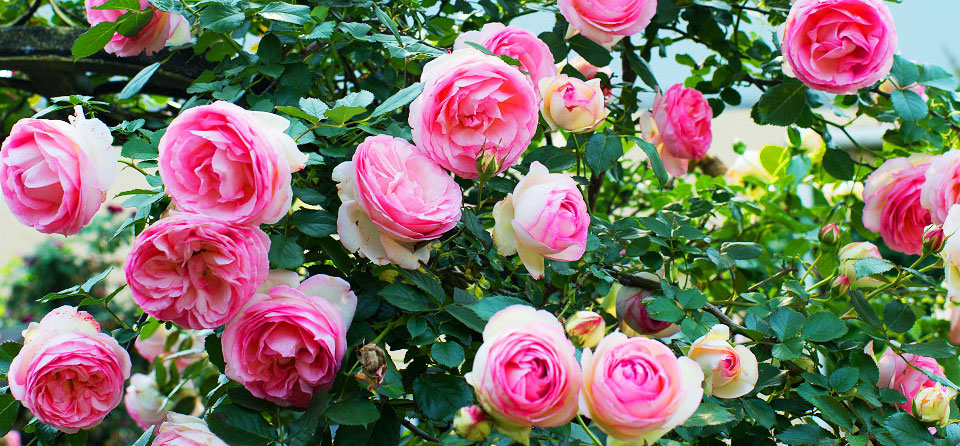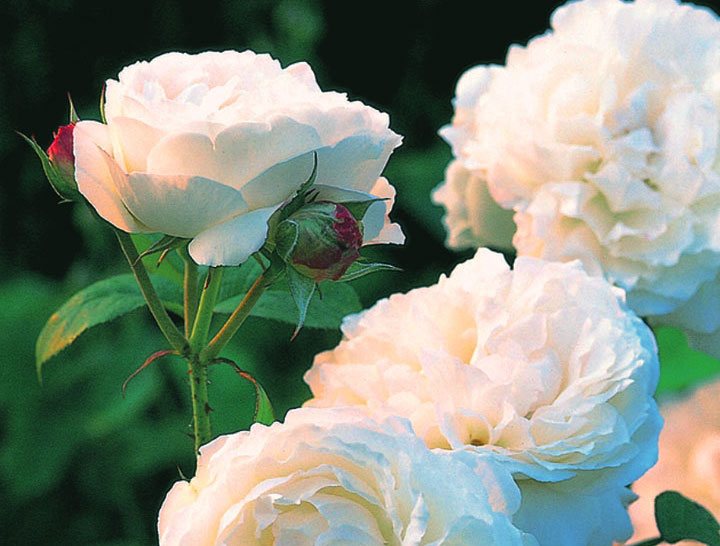The prominent advantages of old Chinese garden roses are their constant blooming in all seasons, wide variety of flower colors, and pleasant fragrance. The representative species, China rose, was selected and bred by the ancient Chinese people during a long period of horticultural activity. The earliest tangible written record of its Chinese name Yue-ji-hua occurs in the Northern Song Dynasty. In the book A Brief Introduction of the Local Products in Yi State (today’s Chengdu). Blooming repeatedly or perpetually, Rosa chinensis stands for ‘four seasons’ and ‘everlasting spring’ and has become a symbol of people's good wishes for safety, health, and longevity. The motifs also appeared on traditional paintings, clothing, jewels, and artifacts, etc. In literary men's writings, R. chinensis also has the strength of a distinct fragrance beyond the peach and plum and a competitor against the plum blossom in the snow and frost.
In ancient Europe, Rosa species frequently appear in mythology, poetry, fiction, painting, and music. Under various common terms, this special flower has witnessed dynastic changes, been integrated into religious activities, carried different connotations in different historical periods, and gradually evolved into the embodiment of eternal and immortal beauty. After the Renaissance, roses became the most mainstream symbol of secular love. The principal disappointment of the old garden roses of Europe was that they usually bloom only once a year, and the flowers were limited in a range of colors.
From the late 18th to the mid-19th century, some outstanding varieties of old Chinese garden roses were gradually introduced to Europe. The encounter between East and West unveiled the development of the modern Rose. In 1867, French horticulturalists bred the first cultivar of the Hybrid tea rose, Rosa 'La France.' It was based on old garden roses from China and Europe and is generally recognized as the starting point of modern roses. As science, technology, economy, and cultural exchanges have advanced, the desirable characteristics of China garden roses (ever-blooming, true red and yellow-colored flowers) have been recognized; the selection, breeding, and horticultural work of breeding modern roses in western countries, has experienced a period of vigorous development. In just two centuries, the modern roses have become a huge family consisting of nearly 30,000 varieties! Understandably, people’s enthusiasm for them has multiplied.
After the mid-20th century, large-scale commercial flower cultivation flourished. Fresh cut flowers have become an important commodity and the modern roses area among the top four cut flowers. Hybrid Tea roses, which account for about one-third of modern roses, are the epitome cut flowers. Because the Rose symbolizes and helps express love and beauty in contemporary life, it quickly gains popularity. On all of those beautiful holidays, celebrations, anniversaries, or any ordinary day, they have found their way into hundreds and thousands of homes. The word rose in Western literature and art is often translated into Chinese as Mei-gui in modern and contemporary times. The trade name of modern rose cut-flowers is also unconsciously given the name Mei-gui rather than Yue-ji although, in Chinese, the latter means modern roses exactly. Perhaps it is because of literary men and women and translators' preference, or maybe the Chinese name Mei-gui has a romantic aura.
The true Mei-gui, Rosa rugosa, is a native species of East Asia. A sister of old China garden roses, with ordinary appearance but having a rich fragrance, is used more for the food and perfume industry than in gardens. Its beautiful name was stolen for modern roses, and the modern roses consequently lost their names. The story of the genus Rosa has been woven into the material and spiritual life of humanity's quest for love and beauty for thousands of years. Today, its attachment with human beings continues.
In addition to the most diverse and colorful Hybrid tea roses, there are many other excellent strains of modern roses. The Floribunda roses, which have slightly smaller flowers but are highly suitable for streets and flower beds. The Grandiflora roses, which have large flowers with a cluster-flowered habit. The Miniature roses are dwarf plants and are suitable for containers. The Climbing rose wanders and rambles and is ideal for walls, fences, and corridors. Some of those old garden roses and Rosa species, like, China rose, Gallica rose, fragrant, and cold-tolerant Hybrid perpetual roses, are still widely cultivated today.
In his masterpiece The Little Prince, the French writer Saint-Exupery wrote: It is the time you have spent on your Rose that makes your Rose so important. This is about love, but it can also be about gardening itself. The little prince's Rose, which was translated in Chinese as Mei-gui, may also be a modern rose, but as long as love is real, it may not matter which rose it is or whether the Mei-gui is real or not.







